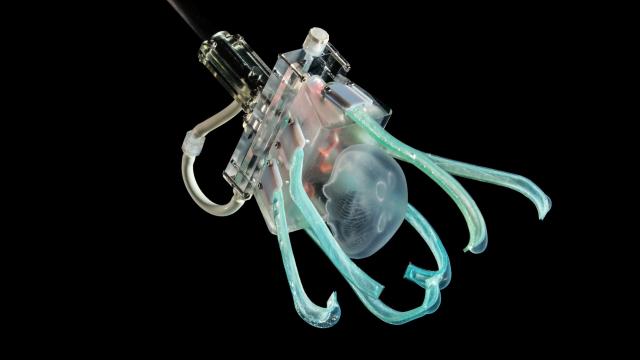Forget flies—this robot is so gentle, it wouldn’t hurt a jellyfish.
Which is saying a lot, since the gelatinous lifeform is especially prone to damage, according to David Gruber, a marine biologist at City University of New York. “Some of them fall apart just when they’re in your hand,” he said. “They’re this fragile ball of floating, soft material.”
Researchers can accidentally squish or mangle jellyfish and other delicate deep-sea creatures when they try to collect them for study. The common implements—nets, suction vacuums, and metal grippers—are particularly unfriendly to jellyfish. “As a marine biologist, it always kind of pained me to think about how we studied these animals,” said Gruber. “If we could operate without harming a jellyfish, we’d be doing something right. It’s the Mount Everest of delicate animals.”
In August 2019, Gruber and a team of Harvard engineers unveiled a squishy, flexible-fingered robot designed to more carefully handle marine animals. In a paper published today, the group went one step further and demonstrated that their noodle-y robot was not only physically softer but also stressed jellyfish far less than traditional collection devices. “You can’t just ask a jellyfish: ‘How’re you doing?’” said Michael Tessler, a co-author and American Museum of Natural History biologist. “This seems like confirmation that we’re on the right track.”
The invention features six noodle-like appendages composed of soft silicone reinforced with strong but lightweight nanofiber sheets; it can curl and uncurl thanks to a hydraulically pressurised channel inside each finger. Engineer Nina Sinatra, who developed the robot at Harvard’s Microrobotics Laboratory, is a scuba diver and has seen jellyfish up close, so she understood the challenge of designing something delicate, quick, and precise enough to handle them without any tearing or poking.
“They have to be gentle enough that they can interact with organisms but durable enough that you can plunge them thousands of meters in the ocean,” Sinatra said. “I dove right in, pun intended.”
With the design complete, researchers wanted to observe the animals’ less-visible response to the invention’s touch. Last fall, they ran experiments on common, or moon, jellyfish and analysed their transcriptomes, which capture a snapshot of what genes are being expressed.
When researchers compared one minute’s worth of soft-robot handling with the same amount of time with the metal claw grabber, they found jellyfish were far less stressed on a molecular level with the new invention. In fact, they found some genes associated with the prevention of cell death were activated under metal claw conditions but not at all with the softer technology.
“You assume the linguine fingers are going to be more gentle, but no one had ever tested it,” said Mercer Brugler, a co-author and biologist at the New York City College of Technology. “Thankfully, we did find it was a less stressful experience for them.”
The experiment, however, was not a study of jellyfish pain, Brugler noted. Unlike a human, whose brain consists of billions of neurons, a jellyfish instead has a primitive, decentralized net of nerves that can respond to stimuli but lacks the ability to process pain or experience consciousness, as far as we know. “They definitely get wounded, and then they repair,” Gruber said. “This opens up interesting questions about how jellyfish experience stress. If they’re turning on their cell repair, is that similar to pain?”
Jellyfish are just one in a diverse lineup of precious deep-sea lifeforms biologists would like to harmlessly swab, monitor, sample, and observe; others include ancient glass sponges and 4,000-year-old black corals (one of Brugler’s research interests). This winter, the team will test their soft robot outside of a lab, during a scientific cruise in New Caledonia, Australia.
“We’ve only explored maybe 5 per cent of the deep sea. Every time we go down in submersible or with robots, we find new things,” Brugler said. “Until we know more, we have to be respectful of these long-lived things.”
To that end, the new paper reflects a growing call for environmental stewardship within the scientific community and low-impact research practices in precious or hard-to-access ecosystems. “It’s not mainstream yet, but I’m hoping it’s becoming more so,” said Gruber, who in other projects has paired marine biology and technology to develop a camera that mimics shark vision and AI approaches to whale bioacoustics. “We’re making a statement about approaching the deep sea with care.”
It’s a novel concept for robotics, too, Sinatra said. “As an engineer, you think about who or what you’re designing for,” she said. “In this case, the user is an animal—not a human.”
Marion Renault is a freelance science journalist born in France, bred in the Midwest, and now based in Brooklyn. Her work has appeared in Popular Science, The New York Times, and The Atlantic.
